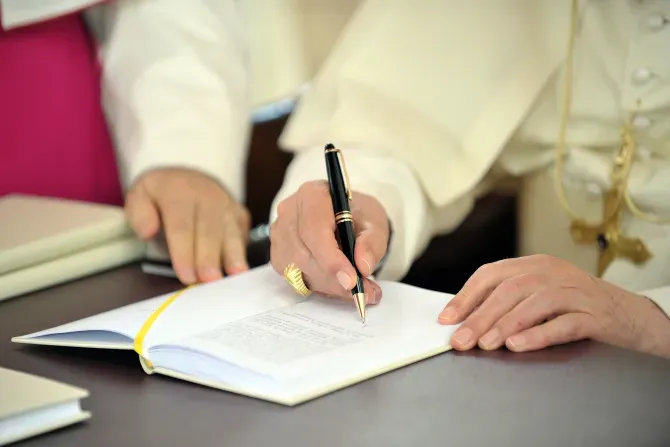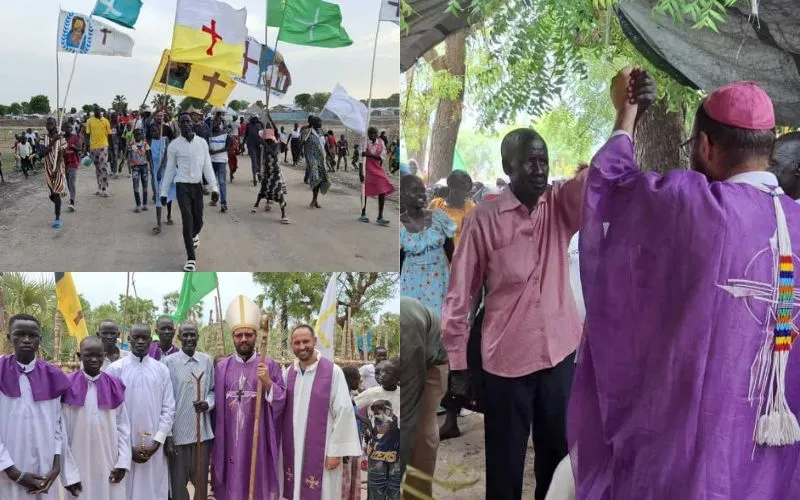He also anticipates the inevitable course of Western culture, with its sexual and moral libertinism in the name of a false and diabolical freedom: “Fecundity separated from marriage based on a life-long fidelity turns from being a blessing (as it was understood in every culture) into its opposite: that is to say a threat to the free development of the ‘individual’s right to happiness.’ Thus abortion, institutionalized, free and socially guaranteed, becomes another ‘right’, another form of ‘liberation.’”
“Called to Communion: Understanding the Church Today” (1996)
Published a decade after “The Ratzinger Report,” this relatively short work was described by its author as a “primer of Catholic ecclesiology.” Indeed, Ratzinger focuses on the nature and the mission of the Church, but as he always did when speaking and writing on the Church, he goes to the very heart of things: only by embracing a Christocentric and eucharistic life can we truly understand the Church. That deep but accessible Christological lens for approaching the Church brings with it immense ramifications for the believer.
Divided into five chapters with an epilogue, “Called to Communion” looks at: The Origin and Essence of the Church; The Primacy of Peter and the Unity of the Church; The Universal Church and the Particular Church: The Task of the Bishop; On the Essence of the Priesthood; A Company in Constant Renewal.
It is possible to see in this work the immense achievement of Ratzinger’s own doctoral dissertation on the theology of St. Augustine as well as his reflection spanning the decades since. He builds on St. Paul’s description of the Church as the Body of Christ to help the reader understand the proper role and function of its members.
(Story continues below)
“Called to Communion” also confronts the major theme in Ratzinger’s writings on true and false reform in the Church. It is a question especially pertinent to today in the frequent calls to remake the Church in our own image, exemplified by the German Synodal Path. As he writes: “What is great and liberating about the Church is not something self-made but the gift that is given to us all. This gift is not the product of our own will and invention but precedes us and comes to meet us as the incomprehensible reality that is ‘greater than our heart’ (cf. 1 Jn 3:20). The reform that is needed at all times does not consist in constantly remodeling ‘our’ Church according to our taste, or in inventing her ourselves, but in ceaselessly clearing away our subsidiary constructions to let in the pure light that comes from above and that is also the dawning of pure freedom.”
“Salt of the Earth” (1997)
The first of four book-length interviews that Ratzinger gave to German journalist Peter Seewald — with “God and the World” (2002), “Light of the World: The Pope, The Church and the Signs Of The Times” (2010) and “Last Testament: In His Own Words” (2016) — “Salt of the Earth” followed in the footsteps of “The Ratzinger Report” both in style and many of its themes. Seewald was granted the opportunity to sit and interview the then-cardinal for an hour a day over the course of several days, but he also had the valuable permission to ask difficult questions from a cardinal who had not received the questions ahead of time. The result is a book, like “The Ratzinger Report,” that is filled with blunt but charitable assessments of the state of the Church and the world.
Two aspects of the book are especially valuable. First, it begins with his own personal reflections on his family and then his progression to being a priest, theologian, and bishop. Second, the interview was given shortly before the end of the 20th century and the start of a new millennium, meaning that he was able to consider the crises of the past, the challenges for the future, and the hope of a new millennium.
Seewald raises a host of questions, including the great moral controversies as well as the so-called “canon of criticisms” always thrown at the Church: celibacy, women’s ordination, and remarriage for divorced persons. Ratzinger’s answers are important in expressing again that there is a fixation on the criticisms by liberals to the great detriment of the mandate to proclaim the Gospel.
“There is too little attention to the fact that 80 percent of the people of this world are non-Christians,” Ratzinger replies, “who are waiting for the gospel, or for whom, at any rate, the gospel is also intended, and we shouldn’t be constantly agonizing over our own questions but should be pondering how we as Christians can express today in this world what we believe and thereby say something to these people.”
There is also a remarkable restating of Ratzinger’s fundamental thesis that we must not as Christians abandon the pursuit of truth. Truth, he says, “has to remain the central category. As a demand on us that doesn’t give us rights but requires, on the contrary, our humility and our obedience and can lead us to the common path.”
“Jesus of Nazareth” (2007, 2011, 2012)
The first in a trilogy on the person of Jesus Christ, “Jesus of Nazareth: From the Baptism in the Jordan to the Transfiguration” was the first book written by Pope Benedict XVI after his election. It was followed by “Jesus of Nazareth: Holy Week” (2011) and “Jesus of Nazareth: The Infancy Narratives” (2012).
Pope Benedict brings all his decades of study and prayer to the immense task of revealing Christ to the modern reader and draws upon a vast array of sources to weave a compelling narrative that is also arguably the most accessible of all his writings. It is also notable for the pontiff’s declaration in his introduction that this is in “no way an exercise of the magisterium.” Instead, this is a book by Joseph Ratzinger and a believer’s “personal search for the face of the Lord.” He adds: “Everyone is free, then, to contradict me.” For a theologian who has made Christ the center of all things, it was a daunting task to do justice to the subject matter, and it took years of work, starting in 2003.
Benedict looks at the whole of Jesus’ public ministry, including Jesus’ baptism, the Sermon on the Mount, the meaning of the parables, the Calling of the Twelve, the Confession of Peter, and the Transfiguration. Throughout he asks the question, “What did Jesus actually bring?”
Benedict replies: “God. He has brought God! He has brought the God who formerly unveiled his countenance gradually first to Abraham, then to Moses and the Prophets, and then in the Wisdom Literature — the God who revealed his face only in Israel, even though he was also honored among the pagans in various shadowy guises … He has brought God, and now we know his face, now we can call upon him. Now we know the path that we human beings have to take in this world. Jesus has brought God and with God the truth about where we are going and where we come from: faith, hope, and love.”








